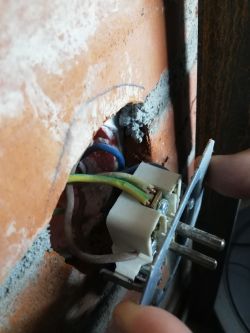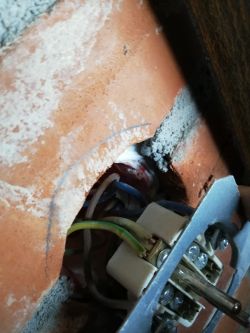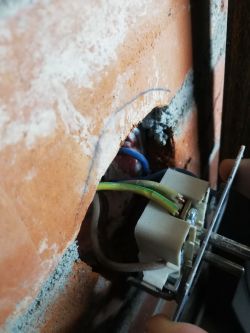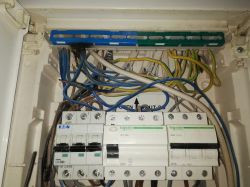FAQ
TL;DR: Partial apartment power loss with no blown fuse usually means a loose neutral. Repair ran 250 PLN in 20 minutes; the electrician said it's "a miracle that the equipment did not burn down." Power off and call a pro. [Elektroda, Labatek, post #17555084]
Why it matters: For residents facing dead sockets and flickering lights, this FAQ explains quick checks, real costs, and when to call an electrician.
Quick Facts
- No breaker trip typically signals an open circuit, not a short. [Elektroda, Witold5, post #17551634]
- A loose neutral at the panel terminal can overheat and “fry” the conductor. [Elektroda, Robert B, post #17551764]
- Junction boxes between the switchboard and sockets are key inspection points in newer homes. [Elektroda, Witold5, post #17551703]
- Safety first: call an electrician ASAP if other neutrals could be loose. [Elektroda, zworys, post #17553141]
- Real-world fix here: 250 PLN and about 20 minutes on site. [Elektroda, Labatek, post #17555084]
Why didn’t my breaker trip when part of the apartment lost power?
Because nothing shorted. A break or loose connection opened the circuit, so the breaker saw no fault. Flickering before the outage points to a high-resistance joint. As one expert wrote, “there was no short circuit, only a break in the circuit.” Tighten or re-terminate that suspect connection. [Elektroda, Witold5, post #17551634]
What’s the most likely cause after a vacuum made lights flicker, then sockets died?
Most cases like this involve a loose neutral at the panel or junction box. Heat and arcing then damage the conductor. As noted, “neutral wire was sloppyly screwed to the terminal block and therefore fried.” Have a licensed electrician clean, re-terminate, and torque the neutral. [Elektroda, Robert B, post #17551764]
Is it safe to keep power on if I suspect a loose neutral?
It is unsafe. A loose neutral can cause voltage swings, equipment damage, or fire risk in other rooms. Get an electrician “as soon as possible” to prevent “big problems.” Do not keep re-energizing a damaged circuit. [Elektroda, zworys, post #17553141]
How do I safely do a quick pre-check before calling an electrician?
Do a minimal pre-check only if you know your installation.
- Inspect the affected outlet for loose wires.
- Check the breaker for the sockets and tighten its terminal screws.
- If anything seems unclear, stop and call an electrician. “However, if you do not have knowledge, an electrician will be better.” [Elektroda, Witold5, post #17551648]
Where should I look for the fault: breaker box or junction boxes?
Trace the run from the switchboard to the outlets. Remove the board cover, inspect and tighten connections, and verify output voltage at the socket breaker. Then check junction boxes (“cans”) between the board and the sockets. These spots often hide a bad joint. [Elektroda, Witold5, post #17551703]
What does a burned neutral look like, and what happens if I re-energize it?
A burned neutral shows darkened insulation and heat damage at the terminal. When re-energized, it may spark and fail dramatically. The poster saw a spark and burned cables immediately after restoring the main switch. Do not reapply power until a pro repairs it. [Elektroda, Labatek, post #17551754]
Do burned wires always need replacement, or can they be repaired?
Not always. Lightly damaged conductors can be trimmed and re-terminated by a professional. Severely charred sections require replacement. The expert advice here: “Not necessarily replacing, but repairing for sure.” Let a qualified electrician decide on-site. [Elektroda, Witold5, post #17551760]
How much might this repair cost and how long could it take?
Expect a quick fix once the fault is located. In this case, the repair cost 250 PLN and took 20 minutes. That aligns with a straightforward panel connection repair. Ask for a receipt and a report on the cause. [Elektroda, Labatek, post #17555084]
Can I recover repair costs from the installation contractor?
Yes, if poor workmanship caused the loose connection. The advice given: bill the installation contractor for the repair. Document the fault and keep the electrician’s note and photos. [Elektroda, Robert B, post #17551764]
Why did my lights blink before everything went out?
Blinking indicates a loose or resistive joint intermittently making contact. Heat and vibration worsen it under load, like a vacuum cleaner. The expert explained the flicker came from slack in the wires. Fix the weak joint promptly. [Elektroda, Witold5, post #17551634]
How many rooms can one bad connection knock out?
A single bad connection can drop power to all outlets on that circuit. Here, two rooms lost socket power at once. That scope helps your electrician isolate the affected branch. [Elektroda, Labatek, post #17551620]
What tool helps confirm if the breaker is supplying voltage?
Use a meter to check the breaker’s output voltage for the socket circuit. That confirms whether the fault is downstream. One expert advised to “check the output voltages from these fuses.” Only qualified people should test live circuits. [Elektroda, Witold5, post #17551703]
Who should I call to fix this?
Call a qualified electrician. If you lack experience with your installation, you can hurt yourself. Faults may sit in the board, boxes, or wiring runs. Describe the symptoms and let them investigate. [Elektroda, zworys, post #17551741]
After the fix, should the electrician inspect other neutrals in the panel?
Yes. Ask the electrician to inspect every neutral in the panel. If one was loose, others may be too. As warned, loose N conductors elsewhere can cause “big problems” across the house. [Elektroda, zworys, post #17553141]
 (I am attaching a photo of the fuse box, it may be useful.
(I am attaching a photo of the fuse box, it may be useful.







